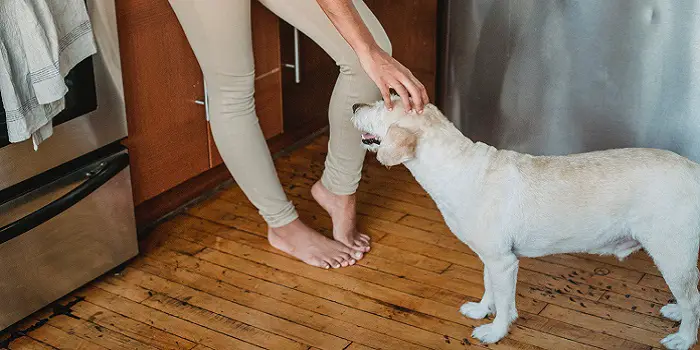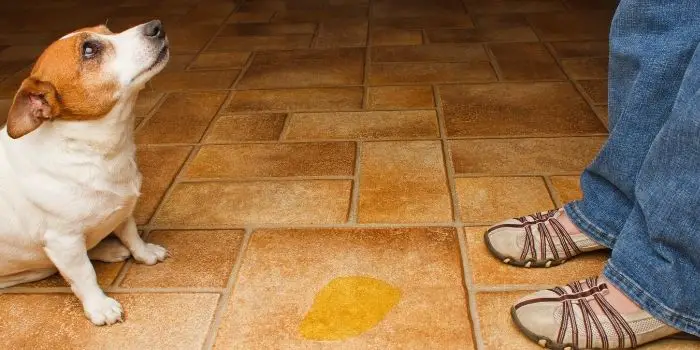
No matter what pet you have – cat or dog – their urine can cause damage to floors and subflooring even if the floor has been sealed.
Although the urine won’t compromise the structural strength, it does leave behind stains that lead to black spots. It also generates a musty smell, which can be difficult to air out.
Particularly, if dog pee is left too long on the floor, it can leave a nasty ammonia odor in the home.
Without immediate action, it’ll be harder to remove the smell and black urine stains from the flooring. Also, the long-term standing of dog pee could result in a permanent stain and lead to mold and mildew growth and proliferation.
So, what steps do you need to take to eliminate the urine off your hardwood floors?
Let’s check them out…
How to Get Dog Urine Off Your Hardwood Floors?
Keep in mind, that pet urine causes damage to all kinds of floors, including sealed and unsealed hardwood floors.
When you have a pet, such as a puppy, you may discover some places where your dog has peed.
If the pee has been allowed to stand for a time, it’ll soak into the hardwood. To remove these unsightly, smelly stains, you can follow these tips and treatments…
1- Clean as You Normally Would
If there is any dog urine or feces on the wood floor, you’ll need to clean it up first with paper towels.
Then use a rag to clean up the area, by dabbing or blotting it in warm soapy water.
If area rugs or carpets have been peed on, you’ll want to remove them to air out. This also gives you a good look at where your floors need to be remediated.
While cleaning, make sure that you do not rub the floors as it can cause scratches!
2- Room Ventilation
You want your room to air out – either through an open window or a fan. The key is to eliminate odors and floating particles.
Ventilation also helps in getting rid of the toxic fumes that get generated with the cleaning method.
3- Use Hydrogen Peroxide
If you’re the type of person to tackle jobs yourself, the hydrogen peroxide method works fairly well.
It’s regarded as an eco-friendly wood-bleaching agent and can sanitize your floor to get dog urine out completely.
- Use hydrogen peroxide right on the area where the urine has stained.
- Pour hydrogen peroxide on a clean cloth and cover the hydrogen peroxide already on the floor.
- Let the hydrogen peroxide soak up the stain by leaving the hydrogen peroxide on the stain for roughly 15 to 20 minutes.
- But if you notice lingering smells or stains, keep the cloth on for 24 hours.
This should help to eliminate the odor and stain. If the spots are deeply soaked with urine, repeated treatments may be necessary.
4- Vinegar Solution Can Benefit
The acidic nature of white vinegar can neutralize alkaline ammonia which can help eliminate odors.
It’s also worthwhile in killing germs and bacteria found in dog urine.
But, how do you use the vinegar solution method to remove the pet stains of wood?
- In a 1:1 ratio, mix water and white vinegar together. You can also buy a vinegar solution, but they generally only have five percent vinegar in them.
- Add grapefruit oil to the solution if the smell is potent and has spread to other areas of the home. The grapefruit oil is a natural deodorizer and helps with removing odors.
- Spray the solution on the problem area of the floor and scrub.
- Use clean water and rinse the floor after you have scrubbed it.
- Finish with a dry mop. You can also use a wet/dry vacuum to deal with the excess moisture and get rid of the dog urine.
5- Get Some Baking Soda Solution
Baking soda is a great home remedy that also works wonders in removing dog stains and urine smells.
It has a PH of more than seven and is an alkaline-crystalline powder, which means it can neutralize the urine’s acidic content. This leaves an odorless neutral pH state.
How do you use this homemade odor-removal cleaner product to bring new life to your floor?
- Lightly sprinkle 1/4 cup of baking soda on the urine stain and let it sit for 24 hours. You do not want to put too much on the area.
- After 24 hours, vacuum it up until it is clean to the touch.
- You can also mix one cup of water with two tablespoons of baking soda, and pour it into the spray bottle.
- Shake the mixture well and spray right onto the stain.
- Let it sit for up to 10 minutes, and use a microfiber or dry towel to clean it.

Will Sanding the Wood Help in Removing Pet Stains?
Older hardwood floors usually have high porous levels, which means pet urine can get deep into the wood and cause even more problems.
The best way to eliminate pet urine, in this case, is to sand the flooring. How do you do this? Follow these easy steps…
Step 1. Check the thickness
Determine the thickness of the floor to see if sanding is possible. Many floors made of thin plywood sheets are not good to sand as they can damage. So, you should avoid sanding such floors.
Step 2. Tape and sand the floor
If the hardwood floor passes the above test, the floor can be sanded. You should now tape the windows and doors before you start sanding since it will create dust.
If you’re going to sand deeply, a drum sander should be used. You should also use an edge sander for baseboards if the urine is near them.
Step 3. Clean and finish with stain-blocking paint
After you have sanded the floor, use a broom to sweep the sand particles up and then mop it to ensure all the rest is gone.
Next, you should consider applying primer paint (like Kilz or Zinser Bin) that is designed for blocking the pet stains and odors on the subfloor.
Although these may cost a bit, the extra step is worth taking if you completely want to block the stubborn pet stains and rancid stinking smell.

What are the Best Dog Urine Stain Removers on the Market?
Dried pee of your puppy or kitten on wood floors not only causes staining, discoloration, and bad odors but also can lead to swelling, bubbling, buckling, or warping of your hardwood floors.
Fortunately, there are a few commercial cleaners that are very effective and can be bought online to clean your pooch’s mess.
The best pet odor and stain cleaners that I have already tried on wooden floors are:
- Simple Green Oxy Dog Stain & Odor Oxidizer
- Nature’s Miracle Dual Action Hard Floor Stain & Odor Remover
- Rocco & Roxie Professional Strength Pet Stain & Odor Eliminator
When picking the floor cleaner for pet urine removal, choose bio-enzymatic cleaners that are more effective at eliminating organic pet messes like urine, potty, and vomit.
Unlike, traditional detergent-type cleaners, these heavy-duty stains, and odor removers work by using natural enzymes and oxygen that targets the pet pee ingredients (like uric acid and ammonia) along with odor-causing bacteria.
No matter what product you select, ensure that you read the label carefully to verify that it’s safe to use on wood and laminate floors.
In case you are not pretty sure, it’s good to do a small spot test first before you use it on a larger visible area.

Ways to Protect Your Floors from Getting Animal Urine Stains and Odor
Your animals are your family, and you want them to be as comfortable as you.
You don’t want to kick them out because they peed on your floor (as accidents can happen).
And, there are things you can do to actually protect your hardwood floor from the damage their urine can cause.
1- Lay Down Pet-Friendly Rugs
Most pets will use the bathroom in a particular area of the home, typically in corners or hidden areas.
You can protect these floors from urine stains and odors by using washable area rugs or carpets that will soak the urine up and absorb odors. This help to protect the wood floors from becoming stained.
2- Consider Waterproofing your Floor
If you’re concerned your pet’s urine will damage your home, you may want to think about waterproof flooring options that include tile, stone, or waterproofed laminate floors.
This kind of floor is comprised of a non-porous layer that keeps liquid from getting through, making it much easier to clean up.
If you have waterproof floors installed in your home and your pet has peed, you can simply use the following steps to eliminate the dog pee.
Wear latex gloves, then with a sponge and water clean up the area your dog peed on.
Next, use a commercial liquid pet odor remover right on the area. Some manufacturers suggest leaving the product in the area for some time to ensure its effectiveness.
After some time, use a clean sponge to wipe the urine odor remover off the floor. Finally, use water to rinse the floor and allow it to dry.
3- Use a Wood Flooring Sealant and a Penetrating Oil
In the majority of cases, dog urine gets into floors where there is little to no sealant applied. If a sealant was used, the urine only gets into the floor and sub-flooring where the floor is scratched.
So, it’s good to use a polyurethane sealant that repeals urine from getting into the floor leaving dark stains.
Penetrating oil, which is pet-friendly, is also helpful in protecting your wooden floors.
The Grapefruit oil will work best for removing pet urine and smell as it gets into the wood grain, strengthening it and making it highly resistant to animal urine.
Use this penetrating oil on the area where damage has been done, not just the whole floor.
4- Cut Your Animal’s Nails to Prevent the Scratches
Your pet animals also have claw nails, which can scratch the floors and leave indentions behind.
These indentions mean pet urine can get into the scratch and lead to dark spots on the floor.
However, if you cut your animal’s nails, you can keep all your floors, tables, doors, windows, and trims from scratching.
The fewer scratches the floor has, the easier it will be to repair and get rid of the urine spots.
Final Thoughts
Dog urine soaked into the hardwood floor can be tricky to deal with, especially when it’s stinking and makes the environment hard to breathe in.
Hopefully, with the above tips and cleaner homemade recipes, you can now treat your plywood subfloor and flooring before putting up your new carpet.
Make sure you take all the precautions while using the chemicals and do the cleaning job patiently.

Hi, I am Mark Garner a professional carpenter, woodworker, and DIY painter. I live in the small city of Peoria, Arizona as a semi-retired woodworker. I have started this blog with a simple motive to help you with my wood experience in this sector. If you like to know more about what I love doing and how it all got started, you can check more about me here.




